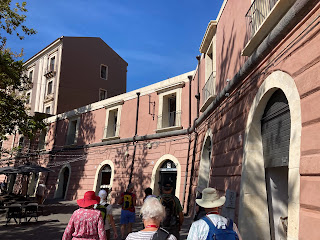This morning we met a local guide for Catania. Our bus took us a short distance to an industrial area near the harbor. This area was heavily bombed in World War II, so many buildings here are newer. But part of the old, bombed out industrial shell remains as a sort of memorial.
There are several museums housed in these ruins. A couple that I might have liked to see were a museum of Italian film, and a museum of writing technology. But our group came to see the war museum that is dedicated to the Allied invasion of Sicily in 1943.
The first exhibit was a reproduction of a piazza as it might have appeared in summer of 1943. The exterior walls of the buildings had fascist propaganda. And one could look through the windows into rooms with collections of antiques representing a living room and a couple of storefronts.
If one stepped toward the back of this exhibit, as if moving to the next area, a motion sensor was tripped. The lights dimmed and an air raid siren began to sound. We continued beyond a stack of sandbags into a replica air raid shelter. There should have been a PTSD trigger warning, because the sound effects of the planes overhead and bombs exploding, coupled with the actual shaking of the room, was very realistic.
When the "all clear" sounded, we moved ahead to the next exhibit in which the same piazza was reproduced, except that now the walls had crumbled, fires burned, and destruction was everywhere. A very effective exhibit.
From there, we continued to exhibits that illustrated the Allied landing and advance. It was a very fine museum with an extensive collection of artifacts, well displayed. But quite frankly, we spent way too much time there. Our local guide went on, and on, and on, with trivia and anecdotes. On our own, we might have spent an hour here, but it was almost three hours before we were back on the bus.
Back in the old historical district of Catania, we walked by 14th century city walls, constructed with volcanic basalt stone from nearby Mt. Etna. We entered the market, which was bustling. Stalls were stocked with all sorts of fruits and vegetables, and the fish were so fresh that some were still moving.
 |
| Thanks to Craig Dorsay for the photo |
At one stall we stopped to watch a young man making nougat. Almonds and pistachios were stirred into sugar water in a large iron pot over a propane fine. When the mixture was thick enough, the pot was emptied onto a slab or marble where he worked it and shaped it with two large knives. It was quite a show!
We've seen a lot of produce markets and fish markets in our travels, but this one was one of the more interesting, especially in a First World country.
The local guide finally left us in the main piazza, in front of the Duomo, after giving us a number of suggestions of things we might wish to do and see on our own during our afternoon free time.
But before free time began, our OAT leader walked us to lunch at a sidewalk restaurant. It was another very good meal, all vegetarian, and again with all the wine we could drink.
The only problem was that by the time we had finished lunch, it was siesta time, and everything the local guide had suggested was closed. We walked around the city, looking for things that were open. A few tourist shops were, but nothing else. Very disappointing.
At 4:30 p.m. our group met again in the hotel lobby and walked several blocks to the same restaurant where we had eaten the night before. This time, however, we went downstairs into the basement. Here we had a presentation from a vulcanologist who talked about Mt. Etna, complete with photos and video.
He was joined by a sociologist who discussed some of the ramifications of life next to a volcano. She pointed out some of the dangers from volcanic ash and lava flows, but also the economics of the tourist trade surrounding the volcano. She pointed out that residents of the area feel an emotional bond to the mountain, sort of a love-hate relationship. "The mountain is our mother," she said.
Following the presentation, we were invited to walk down steps one level below the restaurant basement, into a lava tube. There are remnants of a Medieval pavement that was covered by the lava, and a small underground stream. One man in our group failed to watch his head and got quite a gash from the sharp stone above.
We left for dinner on our own with friends, Craig and Suzy, and walked with them back down into the market area where there are several very highly rated seafood restaurants. We weren't terribly hungry after the big lunch, but we enjoyed a very nice meal before returning to the hotel for the night.






















































